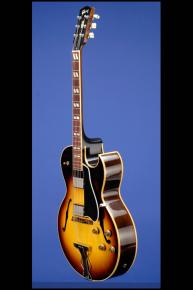An Absolutely Mint July 1958 Double 'PAF' ES-175
This superb 16 1/4-inch-wide guitar weighs just 6.60 lbs. and has a nice, fat nut width of just over 1 11/16 inches and a standard Gibson scale length of 24 3/4 inches. Three-ply laminated maple body, one-piece Honduras mahogany neck with a wonderful thick profile, and Brazilian rosewood fretboard with 20 original 'thin' frets and inlaid pearl split-parallelogram position markers. Headstock with inlaid pearl "Gibson" logo and pearl crown inlay. Single-layer black plastic sheet truss-rod cover with two screws. The body of the guitar is triple-bound on the top and single-bound on the back. Original factory individual Epiphone deluxe closed-back tuners with Keystone plastic buttons. The 'E' on the back of each tuner has an additional line changing the 'E' to a 'G'. Two original 'double-black' PAF humbucker pickups with black rectangular label on the underside and outputs of 7.29k and 8.32k. Original black plastic pickup rings with "MR 491" / "M69 7" and "MR 490" / "M69 8" stamped on the underside. Five-layer (black / white/ black / white / black) plastic pickguard attached to the body by single-pin at treble-side of neck and bracketed single screw on body-side. Four controls (two volume, two tone) on lower treble bout and three-way pickup selector switch on bass horn. Gold plastic bell-shape "Bell" knobs. Rosewood bridge with pre-set compensating saddle on rosewood base and zig-zag tailpiece with central "T"-shaped design. Inside the bass f-hole is an orange label with the style "ES-175D" written in black ink and serial number "A 27889" stamped in black. Inside the treble f-hole is the FON (factory order number) "U 2773 16" which is also stamped in black. This is as close to a mint (9.50) example as one could ever wish for. Housed in its original Gibson five-latch brown hardshell case with pink plush lining (9.00).
"The Chicago Musical Instrument company (CMI), which owned Gibson, bought Epiphone in 1957. When CMI purchased Epiphone, they got all of Epiphone's current stock of parts including bodies, necks, pickups, etc. Gibson used these "New Yorker" parts in conjuction with their own parts when making Epiphones from 1958 to 1961. By 1961 Gibson has used up all the original New York-made Epiphone parts, and then used Gibson parts made in Kalamazoo. Instruments from 1958 to 1969 are commonly referred to as "Gibson/Epiphones"". (http://home.provide.net/~cfh/epiphone.html#intro). The factory fitted Epiphone Deluxe closed-back tuners are totally original to this guitar. With the addition of an 'extra' line on the back of the tuner - the 'E' is changed to a 'G'. Gibson used these superior tuners from their stock of Epiphone parts on some of their high end archtops in the late fifties. We know of two other 1958 ES-175's with these tuners.
This is one of only 285 ES-175Ds shipped in 1958, out of a total production run of 1,681 PAF guitars between 1957 and 1962.
Although the ES-175 was originally introduced in August 1949 (so-called because it initially retailed at $175.00), it only had a single P-90 pickup, and it was not until 1953 that the two pickup version with four controls and a three-way toggle switch was introduced. So successful was this configuration, that Gibson went on to adopt this arrangement for most of its twin pickup guitars.
"At the time the ES-295 was introduced in 1952, the ES-175 was available only as a single pickup model even though a very few models had been custom-ordered with two pickups since its inception in 1949. But it did not take long to realize that a 175 with two pickups would be a neat proposal to consolidate the lower end of the electric range. In early 1953, a 295 was thus converted into a two-pickup 175 and by April the first production ES-175D (D stands for dual pickups) were shipped from the factory. Ted McCarty and Clarence Havenga probably did not fully appreciate it at the time but one of the all-time Gibson classics was born. The affordable 175 and 175D proved immensely popular during the 50s and became the workhorse of many fine jazz guitarists such as Kenny BURRELL, Jim HALL or Herb ELLIS to name just a few" (A.R. Duchossoir, Gibson Electrics -- The Classic Years, p. 55).
"The ES175 is Gibson's most successful electro-acoustic guitar. An estimated 37,000 were sold between 1949 and 1990 and it continues to sell in healthy numbers, despite unprecedented Japanese competition. Dozens of look-alikes and near copies provide testimony to the instrument's dependability, tonal responsiveness and aesthetic quality. From the hundreds of electric guitars which have come and gone over the last fifty years, only a handful have survived with little deviation from their original form...Steve Howe, King Sunny Ade, B.B. King, Mel Brown and Derek Bailey have used the 175 to good effect in other genres. However, it is jazz guitarists who have been seen using the 175 consistently for more than four decades and it is they who provide the instrument's strongest cultural association. Forty [now fifty] years of record sleeves, magazine articles, TV appearances and gigs by eminent jazz guitarists have established the 175 as the pre-eminent jazz guitar. The shape, design and construction of the 175 have changed little in more than forty [now fifty] years of continuous production, affirming its tradition of dependability whilst reaffirming its status as a design classic" (Adrian Ingram, The Gibson ES175: Its History and Players, p. xi).
Translate:












